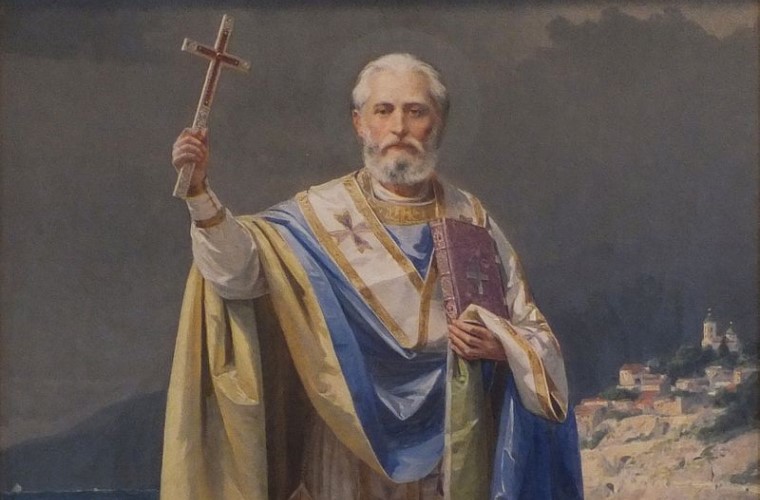This past Sunday, among other notable happenings, we finished our Sunday school series on early church history. While I very much enjoyed going through that study, there is one person in early church history that I never got to mention in our class, a person who inadvertently has become so popular that he is celebrated around the world every Christmas season. While we may know this man today as “Santa Claus” or “Saint Nick,” his original name was Nicholas of Myra.
Nicholas of Myra (c. 270-343) was a bishop (or lead pastor/elder) of the church in Myra, a city on the southern coast of Asia Minor. We know very little about this ancient pastor today except that he served as bishop of Myra during the last, severe persecution of Christians under Diocletian and Galerius (303-313). Nicholas likely also attended the Council of Nicaea, as his name appears on one of the surviving lists of attendees, though no contemporary writer mentions anything further about him. More expansive accounts about the life and ministry of Nicholas do not appear until a few centuries after his death, and their reliability is suspect.
A strong theme of the later accounts of Nicholas, however, is his generosity. One story about him that may be based in truth—since there are no parallels in the stories of other saints—has to do with how Nicholas once saved three young women from ruined lives. A certain wealthy Christian man had suddenly become impoverished and had no money left to provide for the dowries of his three daughters. Without any marriage prospects and no other ability to support themselves, these daughters were considered likely to end up as prostitutes.
Nicholas heard of the dire situation and, either out of modesty or out of a desire to spare the family the public embarrassment of accepting charity, resolved to aid the family secretly. During the night, Nicholas threw a purse of gold coins through the family’s home window, providing enough money so that the first daughter could be married. After her wedding, Nicholas secretly dropped off another bag of money so that the second daughter could also be married. When Nicholas tried to do the same for the third daughter, the father caught Nicholas in the act and insisted on expressing gratitude. Nicholas accepted the thanks but ordered the father not to reveal Nicholas’ secret gift-giving. The father complied (at least initially; we do know about the story today!), and all three daughters ended up safely married.
Alongside this main story about generosity, Nicholas was also said often to put coins secretly in the shoes of those who left them out for him in the night. But other stories about Nicholas and his deeds are much more fanciful. For example, Nicholas supposedly once calmed a raging sea with a word, saving the lives of many sailors. Nicholas also supposedly once raised from the dead three infants, who had been callously butchered during a famine to sell as meat. Still another story reports that, at the Council of Nicaea, Nicholas became so angry with the heretical Arians that he slapped one of them in the middle of assembly—or even punched Arius himself in the face! Though temporarily defrocked and imprisoned for such un-bishop-like behavior, Nicholas was allegedly restored to his position after the council since Arius and his followers became condemned.
These later stories about Nicholas are almost certainly not true, but they did make him an increasingly popular saint in the medieval period, even a favorite. Nicholas became the patron saint of the unmarried, sailors, children, and even the entire country of Greece! The day of his death (December 6) also became a day for secret gift-giving for Christians across Europe, especially among the Dutch. They referred to Saint Nicholas as “Sinterklass” and brought the traditions about him to the New World. Sinterklass would later unite with other traditions about a winter-time gift giver to become the Santa Claus we know today.
Though Nicholas’ saint day (December 6) is still celebrated by many in Europe as a day for secret gift-giving, the date has now become superseded by Christmas Eve and Christmas Day. This shift was encouraged by Protestants in the Reformation period who wanted to distance themselves from the veneration of saints, including Saint Nicholas. Not only did Protestants promote gift-giving on a different date, but they also posited a different gift-giver: the “Christkindl” (the Christ-child). Apparently, this name later mutated into English as “Kris Kringle.”
So, as we celebrate Christmas this year and perhaps even enjoy a Christmas movie or two that includes Santa, let’s remember who the real Saint Nicholas was: not a supernatural gift-giver keeping a list of naughty and nice children, but a simple fourth-century pastor who preached Christ, endured persecution, and practiced self-sacrificing generosity.
Matthew 5:16, Let your light shine before men in such a way that they may see your good works, and glorify your Father who is in heaven.
Questions to Consider:
1. What would the real Saint Nicholas think of all the fanfare about him today?
2. Can Christians rightly incorporate Santa Claus into their Christmas celebration? If so, how?
3. Remembering Christ, how can you be self-sacrificially generous to others this Christmas season?

